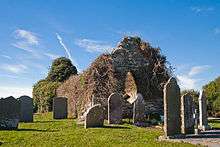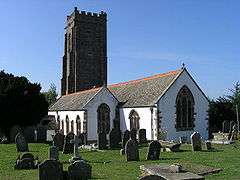Decuman
| Decuman | |
|---|---|
 St. Degumen's Church in Killag | |
| Born |
7th century Rhoscrowther, Pembrokeshire, Wales |
| Died | ca. 706 |
| Major shrine | Watchet, Somerset |
| Feast |
27 February,[1] 27 August[2] |
Decuman (Medieval Latin: Decumanus; Welsh: Degyman; died c. 706) was one of the Celtic saints who came to Somerset from South Wales during the seventh century, arriving on a raft (or his cloak) with a cow for a companion. There he was a pastor and physician to the local inhabitants.
Life and cult
Decuman is said to have been born of noble parents at Rhoscrowther in Pembrokeshire, Wales where the church is dedicated to him. He also had a chapel at nearby Pwllcrochan. Wishing to escape from worldly companions he crossed the Bristol Channel and landed at Dunster: he then became a hermit at nearby Watchet, living from the produce of his cow.
There he is said to have been killed by a pagan. Legend tells that the holy man's head was cut off by "a certain man more venomous than an asp, more poisonous than the adder...." Beheading is a legend which is found associated with several Celtic saints, but in this variant, the saint miraculously picks up his head, washes it, and replaces it. After this the local people assisted Decuman to build the church (Legends and Folklore of Watchet — Ben Norman).
Decuman's Holy Well is located down the lane from the church at Watchet, in Somerset.
Decuman is said to have died in AD 706, though this seems rather late for a Celtic saint. His feast day was celebrated at Somerset on 27 February.[1] The name is said to derive from the Latin decumanus, a farmer of tithes. The saint is associated with several other places in south Wales and also with Degibma, on Loe Pool, near Helston in Cornwall, where there was a chapel dedicated to him.[3][4]
Veneration

Ancient parish
St Decuman was a parish in the hundred of Williton and Freemanners. This parish included Watchet, Williton and many hamlets. It was divided into the civil parishes of Watchet and Williton in 1902.[5]
Wexford
St. Decuman was under the names of St. Degumen or St. Tenen also venerated in County Wexford with three churches in the townlands Ballyconnick, Killag, and Killiane Little dedicated to him.[2] All of them are now in ruins.[6]
References
- 1 2 Challoner, Richard. A Memorial of Ancient British Piety: or, a British Martyrology. W. Needham, 1761. Accessed 14 Mar 2013.
- 1 2 Culleton, Edward (1999). Celtic and Early Christian Wexford. Dublin: Four Courts Press. p. 130. ISBN 1-85182-515-0.
- ↑ Doble, G. H. (1962) The Saints of Cornwall; part 2. Truro: Dean and Chapter; pp. 25-33
- ↑ Cornish Church Guide (1925) Truro: Blackford; p. 217
- ↑ R.W. Dunning (editor), A.P. Baggs, R.J.E. Bush, M.C. Siraut (1985). "Parishes: St. Decumans, including Watchet and Williton". Victoria County History. A History of the County of Somerset: Volume 5. Institute of Historical Research. Retrieved 3 December 2014.
- ↑ See entries 1184, 1254, and 1258 in Moore, Michael J. (1996). Archaeological Inventory of County Wexford. Dublin: Stationery Office. ISBN 0-7076-2326-X.
External links
| Wikimedia Commons has media related to Saint Decuman. |
- Watchet
- holywells.com
- Watchet's Heritage
- The Tale of St. Decuman - Storytelling by Lambert
- The Mystery of St. Decuman - Storytelling by Lambert